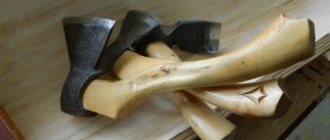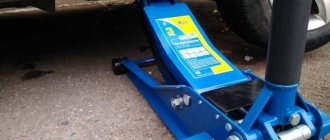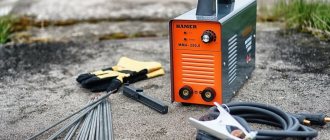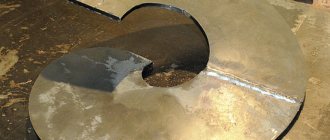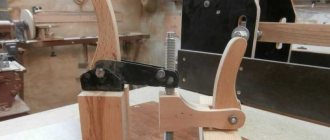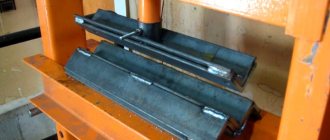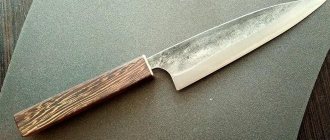Advantages of homemade knives
Sellers have an unspoken rule: “even the most expensive and branded product tends to break or be defective at the very beginning.”
Taking this rule into account, we want to show the following advantages of a homemade knife:
- It is you who are responsible for its quality, and with a high degree of probability you will be able to complete the work to the highest possible quality.
- You can change the blade of homemade knives.
- When working with a knife, you can make your own unique engraving on it.
- You decide for what purpose it will be used.
Features of sharpening the finished product
Sharpening the blade will be correct only if the angle of the blade to the block is chosen correctly. The main principle for choosing a sharpening angle is that the smaller the sharpening angle, the sharper the blade, and the larger the sharpening angle, the longer its sharpness. The universal angle for sharpening is an angle of 20º, but if particularly desired, the master can rely on the following generally accepted values:
- an angle of 30-35º is selected for hunting and folding knives;
- angle 40-45º - for knives that require edge sharpness and increased resistance to dullness;
- 25-30º - angle for household knives;
- 25-40º - selected for sharpening tactical knives.
Sharpening a handmade knife
Sharpening a knife should be accompanied by smooth movements. When sharpening the curve of the blade, you need to slightly lift the handle of the knife, which will create the same sharpening angle around the perimeter of the cutting edge. The direction of the blade should be such that the direction of movement is always strictly perpendicular to the cutting edge.
The simplest knife with your own hands
Now you will learn how to make a knife at home. To get started you will need the following materials:
- Steel.
- Wood, you can also use deer antlers.
- Thick pins made of copper.
- File, band saw for working with steel.
- A stove or heating pad for working with steel.
- Sample.
Having all the necessary equipment and materials, you can safely begin work.
- To begin, select the template you like and accurately transfer it onto the steel. Then, using a machine, carefully cut it out, and then file the knife to give it the desired shape and smooth edges of the handle.
- Next, drill 2 holes and cover them with wood, this will be the handle of the knife.
- Then use a pin to carefully secure the bolts.
- At the end of the work, simply sharpen the blade of the knife, after which it can be used at home.
If you want to make a butterfly knife, then the sequence of actions will be the same. The only difference is the presence of not one blade and handle, but two at once, so that the knife really is a butterfly.
The strongest wood
The main component of wood is cellulose . In its pure form, it is a solid and water-insoluble substance that has a higher strength-to-density ratio than many other materials. That is, this substance would make excellent knives, but in wood its concentration is only 40-50%. The remaining components of wood are water, hemicellulose and lignin, which deprive the material of its strength. American scientists were faced with the task of stripping wood of all unnecessary impurities and leaving only cellulose. A way to do this was found quite quickly.
Cellulose in its purest form
Wooden knife
Now let's talk about how to make a knife from wood. As practice shows, blocks of wood can often be transformed, so we will take a plywood sheet as a basis.
All necessary materials for the work are yours. So let's get started.
- First of all, take the desired template and carefully transfer it to a plywood sheet, then simply cut it out.
- Next, take a file or sandpaper and go well along the edges of the knife so that they become smooth and free of small sawdust.
- Then you should use wood varnish. Apply a thin layer of varnish to your knife and wait 20-25 minutes for it to dry. This manipulation will make it stronger and get rid of harmful parasites.
- The final stage of the work will be its decoration, but what it will be like depends only on your imagination.
Materials and tools
Popular types of wood such as walnut, cherry, beech, oak and birch are considered the best for making knife handles, both in texture and availability. After processing, such wood has a beautiful and smooth surface that is resistant to moisture and chips and scratches.
For all its positive qualities, wood is a rather capricious material. For work, you should select workpieces whose humidity does not exceed 12-15%. Material with a very low moisture content can crack both during the machining stage and during use of the finished sample.
Impregnation is a very effective means of treating wood. To protect the finished product from moisture and give it a finished look, linseed oil drying oil, natural-based varnish, and highly purified mineral oil are perfect. Impregnation is performed as the last stage of processing, after sanding with fine-grained sandpaper. To achieve the best effect, it is good to have turpentine, wax and rosin on hand.
For the mounting method, two-component epoxy adhesive is used. Epoxy resin mixed with wood chips is the best mixture for attaching the shank. If the overhead method is chosen, the rivets are best made from soft non-ferrous metals. You can also purchase ready-made rivets. For manual processing, the minimum set of tools should include: chisels, vices, rasp, files and needle files. To cut wood, you can use a hacksaw with a metal blade. If you have a power tool at hand, things will go much faster. The ability to handle a chisel can be well complemented with a jigsaw or electric drill, then the result can be achieved with minimal time.
Paper knife
To make a knife out of paper, follow these steps:
- Fold a sheet of A4 paper in half.
- Then make a triangle.
- Use scissors to make neat edges and start cutting everything out.
- When you have a knife, you will need to fasten it on both sides; this can be done using PVA glue or a stationery stapler.
- To make the handle, take a small piece of paper, fold it in half and cut out a small rectangle on it. After completing these simple manipulations, you will get a handle for the knife.
What will you need for work?
To make a wooden knife with your own hands, a craftsman cannot do without the following tools:
- wooden hammer;
- saws or jigsaws that will be needed to cut out the workpiece;
- pencil;
- chisels;
- cutting knife;
- sandpaper;
- one wooden block.
The first thing experienced craftsmen do is prepare a wooden block. The workpiece must be thoroughly cleaned of bark. You also need to have an idea of what the design of a wooden knife should be. After the master has decided on the size and shape of the future product, a drawing is drawn on the surface of the bar.
Photo tips on how to make a knife
https://www.youtube.com/watch?v=UFpBcssdYyU
